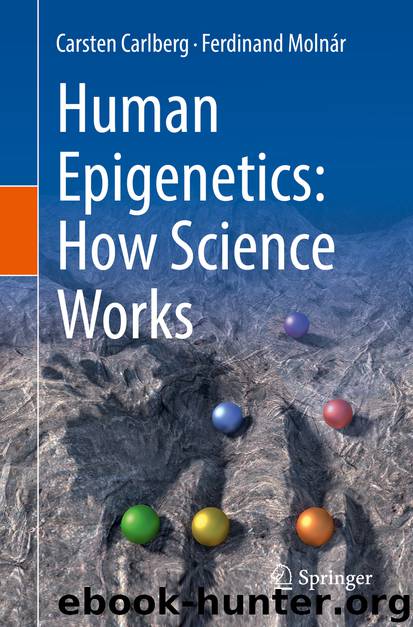Human Epigenetics: How Science Works by Carsten Carlberg & Ferdinand Molnár

Author:Carsten Carlberg & Ferdinand Molnár
Language: eng
Format: epub
ISBN: 9783030229078
Publisher: Springer International Publishing
The agouti mouse model was used for the following experiment: two weeks before mating with male Avy/a mice, female wild-type a/a mice were either supplemented or not with methyl donors, such as folate, vitamin B12 and betaine (Fig. 7.1, Box 10.1). The supplementation was continued during pregnancy and lactation. While the F1 generation of non-supplemented mothers displayed the expected number of yellow color phenotypes, the offspring of supplemented mothers shifted toward a brown coat color phenotype. This suggests that maternal methyl donor supplementation leads to increased Avy methylation in the offspring. Furthermore, this means that an environmentally induced epigenetic drift in the mothers was inherited to their children. The inheritance of an epigenetic programing to the next generation indicates that at least metastable epialleles, such as IAP, are able to resist the global demethylation of the genome before pre-implantation (Sect. 6.1).
Interestingly, when Avy mice were fed with a soy polyphenol diet causing changes in their DNA methylation patterns, their offspring was protected against obesity and diabetes across multiple generations. In another mouse model, maternal undernutrition leads to low birth weight and glucose intolerance in male and female F1 offspring. Exposure to suboptimal nutrition during fetal development in utero leads to changes in the germ cell DNA methylome of male offspring, even when these males were nourished normally after weaning. These phenotypic differences are transmitted through the paternal line to the F2 offspring. More than 100 regions in the F1 sperm genome from maternally undernourished male offspring were found to be hypo-methylated compared to controls. This indicates that PGCs from nutritionally restricted fetuses did not completely remethylate their DNA. Taken together, the different rodent models indicate that epigenetic memory can be passed from one generation to another by inheriting the same indexing of chromatin marks. From the different types of chromatin marks, DNA methylation seems to be designed in particular for a long-term cell memory, while short-term “day-to-day” responses of the epigenome are primarily mediated by non-inherited changes in the histone acetylation level. Histone methylation levels are in between both extremes.
The mouse models impose the question whether the concept of an epigenetic memory and inheritance is also valid for humans. There are no comparable natural human mutants, and for ethical reasons human embryonal feeding experiments are not possible. However, there are natural “experiments”, such as the Dutch Hunger Winter, where individuals were exposed in utero to an extreme undernutrition occurring in the Netherlands during the winter of 1944/45. Fetal malnutrition led to impaired fetal growth. Low birth weight favors a thrifty phenotype that is epigenetically programed to use nutritional energy efficiently, i.e., to be prepared for a future environment with low resources during adult life. Even many decades after birth the in utero undernourished individuals showed subtle (<10%) changes in DNA methylation at several loci in adulthood, for example, at the regulatory region of the imprinted gene IGF2 (Sect. 3.3). This epigenetic pattern is associated with an increased risk of obesity, dys-lipidemia and insulin resistance, when the respective individuals are exposed to an obesogenic environment.
Download
This site does not store any files on its server. We only index and link to content provided by other sites. Please contact the content providers to delete copyright contents if any and email us, we'll remove relevant links or contents immediately.
| Cell Biology | Developmental Biology |
| Entomology | Marine Biology |
| Microbiology | Molecular Biology |
| Biostatistics |
Sapiens: A Brief History of Humankind by Yuval Noah Harari(13036)
The Tidewater Tales by John Barth(12025)
Do No Harm Stories of Life, Death and Brain Surgery by Henry Marsh(6332)
Mastermind: How to Think Like Sherlock Holmes by Maria Konnikova(6220)
The Thirst by Nesbo Jo(5777)
Why We Sleep: Unlocking the Power of Sleep and Dreams by Matthew Walker(5636)
Sapiens by Yuval Noah Harari(4528)
Life 3.0: Being Human in the Age of Artificial Intelligence by Tegmark Max(4491)
The Longevity Diet by Valter Longo(4441)
The Rules Do Not Apply by Ariel Levy(3897)
The Immortal Life of Henrietta Lacks by Rebecca Skloot(3818)
The Body: A Guide for Occupants by Bill Bryson(3788)
Why We Sleep by Matthew Walker(3767)
Animal Frequency by Melissa Alvarez(3749)
Yoga Anatomy by Kaminoff Leslie(3696)
Barron's AP Biology by Goldberg M.S. Deborah T(3626)
The Hacking of the American Mind by Robert H. Lustig(3575)
All Creatures Great and Small by James Herriot(3506)
Yoga Anatomy by Leslie Kaminoff & Amy Matthews(3391)
